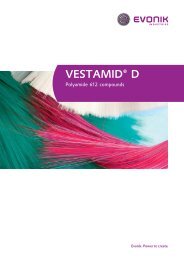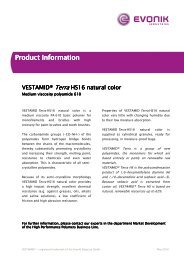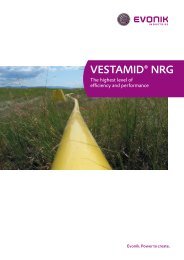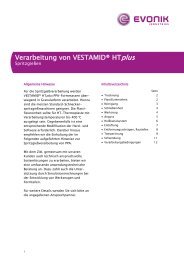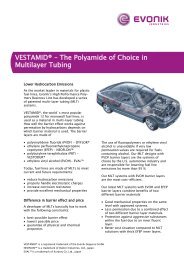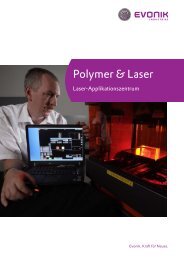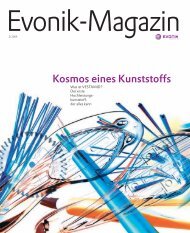VESTAMID® Terra - Hightech plastics from the field
VESTAMID® Terra - Hightech plastics from the field
VESTAMID® Terra - Hightech plastics from the field
- No tags were found...
You also want an ePaper? Increase the reach of your titles
YUMPU automatically turns print PDFs into web optimized ePapers that Google loves.
DESIGNING WITH POLYMERSProven material for demanding jobs:VESTAMID ® , <strong>the</strong> high-performancepolyamide <strong>from</strong> Evonik, which is usedin gas pressure lines for pressuresbetween 10 and 20 bar (top), inoffshore oil pipelines (below left), andin <strong>the</strong> air conditioning systems of cars(below right)elements28 EVONIK SCIENCE NEWSLETTER27
Correlation between <strong>the</strong> melting temperature Tm and <strong>the</strong> carbonamide groupconcentration (ratio CO-NH 2 to CH 2 ). The bio-based PA 610 has <strong>the</strong>highest melting point of <strong>the</strong> polyamides offered by Evonik, while <strong>the</strong> bio-basedvariants PA 1010 and PA 1012 occupy an intermediate position between <strong>the</strong>long-chain and short-chain polyamidesTm in °CCO-NH 2 /CH 2 -ratio250200150100500PA610åPA612PA1010åPA1012åPA1212Correlation between carbonamide group concentration (ratio CO-NH 2 to CH 2 )and water absorbtion. The bio-based variants PA 1010 and PA 1012 occupyan intermediate position here, too, between <strong>the</strong> long-chain and short-chainpolyamides, while PA 610 displays <strong>the</strong> highest water-absorbing capacity after14 daysWater-absorbing capacity after 14 daysCO-NH 2 /CH 2 -ratio3.53.02.52.01.51.00.50PA610åPA612PA1010åPA1012åPA1212Even with <strong>the</strong> tensile modulus, polyamides PA 1010 and PA 1012,offered under <strong>the</strong> trade name VESTAMID ® <strong>Terra</strong>, close <strong>the</strong> gapbetween long-chain and short-chain polyamidesTensile modulus in N/mm 22,5002,0001,5001,0005000PA610åPA612PA1010åPA1012åPA12120.160.140.120.100.080.060.040.020PA120.160.140.120.100.080.060.040.020PA12PA12Here, Evonik’s objective was to bring bio-basedpolyamides to market maturity. To this end, <strong>the</strong> companyfocused its first efforts not on replacing triedand tested fossil-based products but on selectivelyexpanding <strong>the</strong> range of products and, <strong>the</strong>refore,ap plications. The result is VESTAMID ® <strong>Terra</strong>—agroup of new polyamides whose monomers arebased partly or completely on renewable raw materials.VESTAMID ® <strong>Terra</strong> comprises several variants—PA 610, PA 1010 and PA 1012—that differ in <strong>the</strong>irproperty profile and close gaps in <strong>the</strong> currentlyaccessible property profile of polyamides.New properties tappedThe bio-based PA 610 is <strong>the</strong> polycondensation prod -uct of 1,6-hexamethylene diamine and 1,10-decanedioicacid (sebacic acid). Technically, this variantoccupies a position between high-performancepolyamide 612 and <strong>the</strong> standard poly amides PA 6and PA 66. Because sebacic acid is ob tained <strong>from</strong>castor oil, PA 610 is based up to 62 percent on naturalresources.PA 1010 is syn<strong>the</strong>sized <strong>from</strong> 1,10-decamethy -l enediamine and sebacic acid. With its propertyprofile, it closes <strong>the</strong> gap between long-chained highperformancepolyamides like PA 12 and PA 1212and <strong>the</strong> shorter-chained standard polyamides PA 6and PA 66. Because both monomers are obtained<strong>from</strong> castor oil, PA 1010 is a material based up to100 percent on biological resources. Finally,PA 1012 is created <strong>from</strong> <strong>the</strong> bio-based C10-diamineand fossil dodecanedioic acid and, <strong>the</strong>refore, consistsof up to 45 percent renewable raw materials.Short transport routes for more ecologyCastor oil is obtained <strong>from</strong> <strong>the</strong> seed of <strong>the</strong> Africancastor oil plant, which belongs to <strong>the</strong> Spurge family.Castor oil plants grow primarily in India, Brazil andChina. Each year, about 550,000 metric tons of <strong>the</strong>oil is sold commercially, with Germany importingover 30,000 metric tons annually. The exampleshows that trade with biogenic raw materials is aglobal industry, in which Europe and <strong>the</strong> UnitedStates, as a rule, have to import large quantities tomeet <strong>the</strong>ir demand. This raises <strong>the</strong> question of howenvironmentally sound trade with renewable rawmaterials is when biomasses have to be transportedlong distances <strong>from</strong> <strong>the</strong> point of cultivation to <strong>the</strong>processing location, and <strong>from</strong> <strong>the</strong> processing locationto <strong>the</strong> customer.Evonik’s strategy takes this question intoaccount: Since <strong>the</strong> end of last year, <strong>the</strong> company hasproduced bio-based polyamides, in addition to <strong>the</strong>established products, in a plant south of Shanghai.The monomers used for production are sebacic acid28 elements28 EVONIK SCIENCE NEWSLETTER
DESIGNING WITH POLYMERS(C10 diacid), as well as <strong>the</strong> C10 diamine produced<strong>from</strong> sebacic acid. Sebacic acid is obtained <strong>from</strong> <strong>the</strong>castor oil methyl ester, while C10 diamine is ob -tained <strong>from</strong> sebacic acid and additional chemicalreactions.In <strong>the</strong> plant near Shanghai, <strong>the</strong> monomers are<strong>the</strong>n polymerized and processed to molding compounds.Transporting <strong>the</strong> monomers to Germany—for fur<strong>the</strong>r processing, for example—is unnecessary.In this way, Evonik is not only optimizing <strong>the</strong> flow ofmaterials but also producing as closely as possible to<strong>the</strong> customer: Asia, in particular, where numerousrenewable raw materials are cultivated and harves -ted for chemical products, is a region which Evonikhas targeted for future growth.Also suited to extreme challengesThere is no shortage of suitable applications forVESTAMID ® <strong>Terra</strong>. PA 610 is highly temperatureresistantand is thus well suited for parts that mustwithstand hot conditions, such as <strong>the</strong> engine coversof cars. PA 1010 is also extremely rigid and, as afiber-reinforced variant, especially well suited tohigh-stress housings and similar applications. In contrast,PA 1012 is transparent and stands out for itshigh impact resistance. As an additive in <strong>the</strong> soles ofpremium athletic footwear, it improves absorptionand enhances elasticity. All three re presentatives of<strong>the</strong> VESTAMID ® <strong>Terra</strong> family are semicrystallineand, <strong>the</strong>refore, display high mechanical and chemicalstability.Bio-based polyamides can be used even forextreme applications. One polymer capable of particularlyhigh performance is VESTAMID ® HTplus—apolyphthalamide (PPA) <strong>from</strong> Evonik that permanentlyresists external temperatures over 180 °C. It is used,for example, as a charge air duct in turbochargers, andwill also be offered in a bio-based version beginningin <strong>the</strong> summer of 2009. In <strong>the</strong> Lotus Exige sports car<strong>from</strong> Great Britain, for example, VESTAMID ® HT plusreduced <strong>the</strong> weight of <strong>the</strong> charge air duct by halfcompared to <strong>the</strong> metal duct, and also improved <strong>the</strong>flow properties—saving fuel and minimizing CO 2emissions.Cultivation under extremeconditions is also possibleAs <strong>the</strong> development of <strong>the</strong> VESTAMID ® <strong>Terra</strong> familyproves, raw materials <strong>from</strong> <strong>the</strong> <strong>field</strong> are not onlygood for energy generation or short-lived productsbut also for high-stress high-tech <strong>plastics</strong>. However,being “bio-based” does not necessarily make somethingsustainable and eco-friendly. For example, abio-based product is not practical if <strong>the</strong> use of renew -able raw materials requires a particularly high energyTest passed with flying colors: Closeto-<strong>the</strong>-engineinstallation of a chargeair duct made of VESTAMID ® HTplus,a polyphthalamide <strong>from</strong> Evonik,in a Lotus Exige race car. Evonik willalso offer a bio-based version of <strong>the</strong>material beginning in summer 2009input, if damaging or toxic emissions are releasedduring <strong>the</strong> lifecycle of <strong>the</strong> plastic, or if <strong>the</strong> requiredtransport distances are long. Even when <strong>the</strong> cultivationof biomasses directly competes with food production,technical use can be questionable. In thiscase <strong>the</strong> castor oil plant receives a high score:Because of its drought resistance, it is primarily cultivatedin sites that are unsuitable for o<strong>the</strong>r usefulplants.Because so many factors come into play, a directcomparison of bio-based and fossil raw materials forchemical production is a complex matter. Previousstudies with VESTAMID ® <strong>Terra</strong> prove that <strong>the</strong> biovariantshave an edge on o<strong>the</strong>r products when it comesto greenhouse gas potential and primary energyconsumption. PA 610, for example, requires significantlylower primary energy consumption than <strong>the</strong>chemically similar fossil-based PA 6 or PA 66. For <strong>the</strong>100 percent biological PA 1010, experts anticipatean even lower greenhouse gas potential. Studies arecurrently still underway.>>>elements28 EVONIK SCIENCE NEWSLETTER 29
In general, however, a well-balanced coexistanceof fossil-based and biological raw materials appearsto be <strong>the</strong> most workable solution, because even newstreams of biomasses have to be professionallymanaged. Also, new products—whe<strong>the</strong>r partially orcompletely bio-based—are only really sustainablewhen <strong>the</strong>y meet environmental, economic and socialcriteria to <strong>the</strong> same degree: when <strong>the</strong>y show lowCO 2 emissions and resource consumption, open upsustainable markets, and not least, guarantee <strong>the</strong>customer high quality. VESTAMID ® <strong>Terra</strong> meets allof <strong>the</strong>se criteria.Global Warming Potential* (GWP) of VESTAMID ® <strong>Terra</strong>. Recent studies show thatpolyamides based on bio-renewables outperform purely fossil-based types.If <strong>the</strong> process conditions are optimized, <strong>the</strong> values can be lowered even fur<strong>the</strong>r.*Tentative data. Source: Evonik, PE InternationalCurrent process conditions Optimized process conditionsPolyamideVESTAMID ® <strong>Terra</strong> HS (PA 610, 62% based on bio-renewables)VESTAMID ® <strong>Terra</strong> DS (PA 1010, 100% based on bio-renewables)VESTAMID ® <strong>Terra</strong> DD (PA 1012, 100% based on bio-renewables)GWP in kg CO 2equivalent/kg material4.1 2.62.8 1.13.0 1.5Evonik producesVESTAMID ® <strong>Terra</strong>at a plant locatedsouth of ShanghaiDR. HARALD HÄGERBorn in 1968Harald Häger is <strong>the</strong> Vice President of Process andProduct Development in <strong>the</strong> Evonik High PerformancePolymers Business Line; his work focuses on C12chemistry, long-chain aliphatic polyamides, PPA, PEEK,bio-renewable materials, and lifecycle assessments.He holds a degree in chemistry <strong>from</strong> Philips Universityin Marburg (Germany). After earning his Ph.D. in 1996,Häger worked for almost two years as a PostDoc at <strong>the</strong>university of Dublin (Ireland) and <strong>the</strong>n joined <strong>the</strong> HighPer formance Polymers Business Line in 1998 as anR&D employee. In 2003, he transferred to <strong>the</strong> newly established Functional FilmsProject House, where he was responsible for <strong>the</strong> development of high-performancenano-composites and <strong>the</strong> corresponding processing technologies. Häger accepted hiscurrent position in 2006 after <strong>the</strong> successful completion of <strong>the</strong> project house.+49 2365 49-2351, harald.haeger@evonik.comDR. JÖRG LIMPERBorn in 1960Jörg Limper is responsible for <strong>the</strong> Lifestyle MarketSegment in Evonik’s High Performance PolymersBusiness Line. After studying agricultural sciences andearning his Ph.D. at Justus Liebig University Gießen(Germany), he started his career in 1989 at BoehringerIngelheim Vetmedica GmbH. Limper held a number ofpositions <strong>the</strong>re—his last position being head of R&Dcoordination with responsibility for planning and controllingresearch projects—before moving to <strong>the</strong> FeedAdditives Business Unit of <strong>the</strong> former Degussa in 1995.Beginning in 1996 he headed Animal Nutrition at Applied Technology. In 1999 hetook charge of marketing for <strong>the</strong> feed additive amino acid DL-methionine, and in2004 he also assumed marketing responsibility for <strong>the</strong> amino acid L-lysine. Limperhas worked in his current position since 2006.+49 2365 49-9689, joerg.limper@evonik.com30 elements28 EVONIK SCIENCE NEWSLETTER



